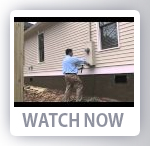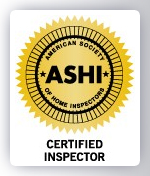ASHI Standards of Practice
Code of Ethics
ASHI’s Code of Ethics stresses the home inspector’s responsibility to report the results of the inspection in a strictly fair, impartial, and professional manner, avoiding conflicts of interest. ASHI Membership Selecting the right home inspector can be as important as finding the right home. ASHI Members have performed no fewer than 250 fee-paid inspections in accordance with the ASHI Standards of Practice. They have passed written examinations testing their
knowledge of residential construction, defect recognition, inspection techniques, and report-writing, as well as ASHI’s Standards of Practice and Code of Ethics. Membership in the American Society of Home Inspectors is well-earned and maintained only through meeting requirements for continuing education.
Find local ASHI Members by calling 1-800-743-2744 or visiting the ASHI Web site at
www.ashi.org
.
ASHI Standards of Practice Effective October 15, 2006
© Copyright 2006 American Society of Home Inspectors, Inc.® All rights reserved
1. INTRODUCTION
The American Society of Home Inspectors®, Inc. (ASHI®) is a not-for-profit professional society established in 1976. Membership in ASHI is voluntary and its members are private home inspectors. ASHI’s objectives include promotion of excellence within the profession and continual improvement of its members’ inspection services to the public.
2. PURPOSE AND SCOPE
2.1 The purpose of the Standards of Practice is to establish a minimum and uniform standard for home inspectors who subscribe to these Standards of Practice. Home inspections performed to these Standards of Practice are intended to provide the client with objective information regarding the condition of the systems and components of the home as inspected at the time of the home inspection. Redundancy in the description of the requirements, limitations, and exclusions regarding the scope of the home inspection is provided for emphasis only.
2.2 Inspectors shall:
A. adhere to the Code of Ethics of the American
Society of Home Inspectors.
B. inspect readily accessible, visually observable,
installed systems and components listed in these
Standards of Practice.
C. Report:
1. Those systems and components inspected that, in the professional judgment of the inspector, are not functioning properly,significantly deficient, unsafe, or are near the end of their service lives.
2. Recommendations to correct, or monitor for future correction, the deficiencies reported in 2.2.C.1, or items needing further evaluation. (Per Exclusion 13.2.A.5 inspectors are NOT required to determine methods, materials, or costs of corrections.)
3. Reasoning or explanation as to the nature of the deficiencies reported in 2.2.C.1, that are not self-evident.
4. Systems and components designated for inspection in these Standards of Practice that were present at the time of the home inspection but were not inspected and the reason(s) they were not inspected.
2.3 These Standards of Practice are not intended to limit inspectors from:
A. including other inspection services or systems and components in addition to those required in Section 2.2.B.
B. designing or specifying repairs, provided the inspector is appropriately qualified and willing to do so.
C. excluding systems and components from the inspection if requested by the client.
3. STRUCTURAL COMPONENTS
3.1 The inspector shall:
A. inspect:
1. structural components including the foundation and framing.
2. by probing a representative number of structural components where deterioration is suspected or where clear indications of possible deterioration exist. Probing is NOT required when probing would damage any finished surface or where no deterioration is visible or presumed to exist.
B. describe:
1. the methods used to inspect under-floor crawl spaces and attics.
2. the foundation.
3. the floor structure.
4. the wall structure.
5. the ceiling structure.
6. the roof structure.
3.2 The inspector is NOT required to:
A. provide any engineering or architectural services or analysis.
B. offer an opinion as to the adequacy of any structural system or component.
4. EXTERIOR
4.1 The inspector shall:
A. inspect:
1. siding, flashing and trim.
2. all exterior doors.
3. attached or adjacent decks, balconies, stoops, steps, porches, and their associated railings.
4. eaves, soffits, and fascias where accessible from the ground level.
5. vegetation, grading, surface drainage, and retaining walls that are likely to adversely affect the building.
6. adjacent or entryway walkways, patios, and driveways.
B. describe:
1. siding.
4.2 The inspector is NOT required to inspect:
A. screening, shutters, awnings, and similar seasonal accessories.
B. fences.
C. geological and/or soil conditions.
D. recreational facilities.
E. outbuildings other than garages and carports.
F. seawalls, break-walls, and docks.
G. erosion control and earth stabilization measures.
5. ROOFING
5.1 The inspector shall:
A. inspect:
1. roofing materials.
2. roof drainage systems.
3. flashing.
4. skylights, chimneys, and roof penetrations.
B. describe:
1. roofing materials.
2. methods used to inspect the roofing.
5.2 The inspector is NOT required to inspect:
A. antennae.
B. interiors of flues or chimneys that are not
readily accessible.
C. other installed accessories.
6. PLUMBING
6.1 The inspector shall:
A. inspect:
1. interior water supply and distribution systems including all fixtures and faucets.
2. drain, waste, and vent systems including all fixtures.
3. water heating equipment and hot water supply system.
4. vent systems, flues, and chimneys.
5. fuel storage and fuel distribution systems.
6. drainage sumps, sump pumps, and related piping.
B. describe:
1. water supply, drain, waste, and vent piping materials.
2. water heating equipment including energy source(s).
3. location of main water and fuel shut-off valves.
6.2 The inspector is NOT required to:
A. inspect:
1. clothes washing machine connections.
2. interiors of flues or chimneys that are not readily accessible.
3. wells, well pumps, or water storage related equipment.
4. water conditioning systems.
5. solar water heating systems.
6. fire and lawn sprinkler systems.
7. private waste disposal systems.
B. determine:
1. whether water supply and waste disposal systems are public or private.
2. water supply quantity or quality.
C. operate automatic safety controls or manual stop valves.
7. ELECTRICAL
7.1 The inspector shall:
A. inspect:
1. service drop.
2. service entrance conductors, cables, and raceways.
3. service equipment and main disconnects.
4. service grounding.
5. interior components of service panels and sub panels.
6. conductors.
7. overcurrent protection devices.
8. a representative number of installed lighting fixtures, switches, and receptacles.
9. ground fault circuit interrupters.
B. describe:
1. amperage and voltage rating of the service.
2. location of main disconnect(s) and sub panels.
3. presence of solid conductor aluminum branch circuit wiring.
4. presence or absence of smoke detectors.
5. wiring methods.
7.2 The inspector is NOT required to:
A. inspect:
1. remote control devices.
2. alarm systems and components.
3. low voltage wiring systems and components.
4. ancillary wiring systems and components.
not a part of the primary electrical power
distribution system.
B. measure amperage, voltage, or impedance.
8. HEATING
8.1 The inspector shall:
A. open readily openable access panels.
B. inspect:
1. installed heating equipment.
2. vent systems, flues, and chimneys.
C. describe:
1. energy source(s).
2. heating systems.
8.2 The inspector is NOT required to:
A. inspect:
1. interiors of flues or chimneys that are not
readily accessible.
2. heat exchangers.
3. humidifiers or dehumidifiers.
4. electronic air filters.
5. solar space heating systems.
B. determine heat supply adequacy or
distribution balance.
9. AIR CONDITIONING
9.1 The inspector shall:
A. open readily openable access panels.
B. inspect:
1. central and through-wall equipment.
2. distribution systems.
C. describe:
1. energy source(s).
2. cooling systems.
9.2 The inspector is NOT required to:
A. inspect electronic air filters.
B. determine cooling supply adequacy or
distribution balance.
C. inspect window air conditioning units.
10. INTERIORS
10.1 The inspector shall inspect:
A. walls, ceilings, and floors.
B. steps, stairways, and railings.
C. countertops and a representative number of
installed cabinets.
D. a representative number of doors and windows.
E. garage doors and garage door operators.
10.2 The inspector is NOT required to inspect:
A. paint, wallpaper, and other finish treatments.
B. carpeting.
C. window treatments.
D. central vacuum systems.
E. household appliances.
F. recreational facilities.
11. INSULATION & VENTILATION
11.1 The inspector shall:
A. inspect:
1. insulation and vapor retarders in unfinished spaces.
2. ventilation of attics and foundation areas.
3. mechanical ventilation systems.
B. describe:
1. insulation and vapor retarders in unfinished spaces.
2. absence of insulation in unfinished spaces at conditioned surfaces.
11.2 The inspector is NOT required to disturb insulation.
See 13.2.A.11 and 13.2.A.12.
12. FIREPLACES AND SOLID FUEL BURNING APPLIANCES
12.1 The inspector shall:
A. inspect:
1. system components.
2. chimney and vents.
B. describe:
1. fireplaces and solid fuel burning appliances.
2. chimneys.
12.2 The inspector is NOT required to:
A. inspect:
1. interiors of flues or chimneys.
2. firescreens and doors.
3. seals and gaskets.
4. automatic fuel feed devices.
5. mantles and fireplace surrounds.
6. combustion make-up air devices.
7. heat distribution assists (gravity fed and fan
assisted).
B. ignite or extinguish fires.
C. determine draft characteristics.
D. move fireplace inserts and stoves or firebox
contents.
13. GENERAL LIMITATIONS AND EXCLUSIONS
13.1 General limitations:
A. The inspector is NOT required to perform any action or make any determination not specifically stated in these Standards of Practice.
B. Inspections performed in accordance with these Standards of Practice:
1. are not technically exhaustive.
2. are not required to identify concealed. conditions, latent defects, or consequential damage(s).
C. These Standards of Practice are applicable to buildings with four or fewer dwelling units and their garages or carports.
13.2 General exclusions:
A. Inspectors are NOT required to determine:
1. conditions of systems or components that are not readily accessible.
2. remaining life expectancy of any system or component.
3. strength, adequacy, effectiveness, or efficiency of any system or component.
4. the causes of any condition or deficiency.
5. methods, materials, or costs of corrections.
6. future conditions including but not limited to failure of systems and components.
7. the suitability of the property for any specialized use.
8. compliance with regulatory requirements (codes, regulations, laws, ordinances, etc.).
9. market value of the property or its marketability.
10. the advisability of purchase of the property.
11. the presence of potentially hazardous plants or animals including, but not limited to, wood destroying organisms or diseases harmful to humans including molds or mold-like substances.
12. the presence of any environmental hazards including, but not limited to, toxins, carcinogens, noise, and contaminants in soil, water, and air.
13. the effectiveness of any system installed or method utilized to control or remove suspected hazardous substances.
14. operating costs of systems or components.
15. acoustical properties of any system or component.
16. soil conditions relating to geotechnical or hydrologic specialties.
B. Inspectors are NOT required to offer:
1. or perform any act or service contrary to law.
2. or perform engineering services.
3. or perform any trade or any professional. service other than home inspection.
4. warranties or guarantees of any kind.
C. Inspectors are NOT required to operate:
1. any system or component that is shut down or otherwise inoperable.
2. any system or component that does not respond to normal operating controls.
3. shut-off valves or manual stop valves.
D. Inspectors are NOT required to enter:
1. any area that will, in the opinion of the inspector, likely be dangerous to the inspector or other persons or damage the property or its systems or components.
2. under-floor crawl spaces or attics that are not readily accessible.
E. Inspectors are NOT required to inspect:
1. underground items including but not limited to underground storage tanks or other underground indications of their presence, whether abandoned or active.
2. items that are not installed.
3. installed decorative items.
4. items in areas that are not entered in accordance with 13.2.D.
5. detached structures other than garages and carports.
6. common elements or common areas in multi-unit housing, such as condominium properties or cooperative housing.
F. Inspectors are NOT required to:
1. perform any procedure or operation that will, in the opinion of the inspector, likely be dangerous to the inspector or other persons
or damage the property or its systems or components.
2. describe or report on any system or component that is not included in these Standards and was not inspected.
3. move personal property, furniture, equipment, plants, soil, snow, ice, or debris.
4. dismantle any system or component, except as explicitly required by these Standards of Practice.











